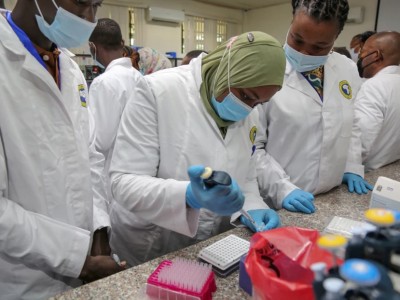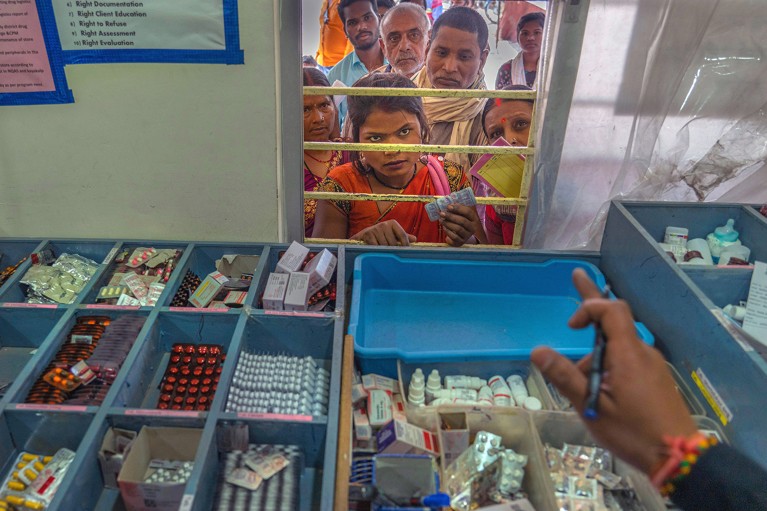
A pharmacist at a health-care centre in India dispenses free medicine to a person with sickle-cell disease.Credit: Rafiq Maqbool/AP Photo/Alamy
Last November, the United Kingdom became the first country to authorize the use of a therapy called Casgevy, based on CRISPR gene-editing technology, for the treatment of sickle-cell disease. Within a few weeks, three other countries — the United States, Bahrain and Saudi Arabia — had done the same. In December 2023, the United States also approved the use of Lyfgenia, another gene therapy, to treat the disease.
Sickle-cell disease kills nearly 400,000 people each year globally. It causes red blood cells to become sickle-shaped and clog blood vessels, which can result in severe pain and tissue damage, among other problems1. More than 75% of people with the disease — one of the most common inherited disorders in the world — are born in sub-Saharan Africa and India. The 2021 Global Burden of Disease Study, a regional and global effort to assess mortality and disability resulting from major diseases, found it to be the 12th leading cause of death globally in children under five1. In Africa, more than 50% of infants or children diagnosed with sickle-cell disease die before the age of five2.
Until the advent of gene therapies, the only cure was a bone-marrow transplant. This requires finding a healthy donor, followed by invasive treatment over weeks3.
Given all this, obtaining regulatory approval for two gene therapies is a phenomenal achievement. Yet at prices of US$2.2 million and $3.1 million per treatment, respectively, for Casgevy (exaxamglogene autotemcel) and Lyfgenia (lovotibeglogene autotemcel), the risk is that both will be withdrawn from the market because too few people or health-care systems can afford them.
This has already happened for four other gene therapies, including a related treatment called Zynteglo (betibeglogene autotemcel), for β-thalassaemia. Another inherited blood disorder, β-thalassaemia causes anaemia, tiredness and weakness in about 3% of the global population, but its incidence can reach 20% in regions including Africa, the Middle East and southeast Asia4. In 2021, Zynteglo was withdrawn from the European market after its developer, the pharmaceutical company Bluebird Bio, based in Somerville, Massachusetts, failed to persuade public bodies such as the United Kingdom’s National Institute for Health and Care Excellence (NICE) to approve it. Zynteglo costs $1.8 million per treatment.
Researchers, drug developers and drug manufacturers are squandering the chance to make gene therapies viable even in wealthier countries, let alone transformative for the world. To seize the opportunity, they must take into account the populations most in need, as well as the global market for treatments — both when developing and when valuing the drugs. This means reconsidering who is enrolled in clinical trials and where those trials are conducted. It also means partnering with low- and middle-income countries (LMICs), and facilitating the development and production of gene therapies in the nations that need them most.
Safe and effective for whom?
Casgevy and Lyfgenia are among the latest examples of treatments (see ‘Forging ahead’) that involve making alterations to people’s genomes through the replacement, deletion or insertion of genetic material. Since 2004, regulators worldwide have authorized 30 other gene therapies for genetic disorders, including immune and red-blood-cell disorders, retinal degeneration and leukodystrophy — a set of conditions affecting the central nervous system — as well as for severe cases of some cancers5. Of the 12 genetic disorders that can now be treated using gene therapies, 9 were previously incurable.
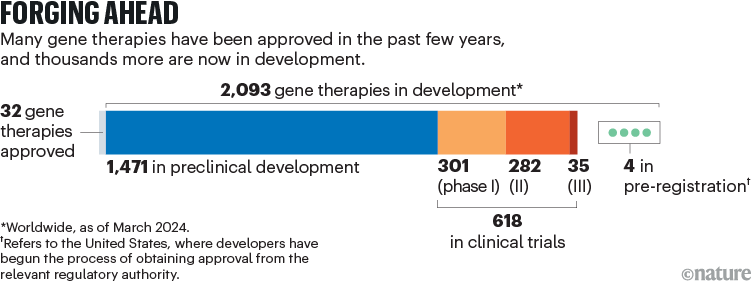
Source: Ref. 5
For Casgevy and Lyfgenia, the challenges didn’t start with costs. In both cases, participants in the clinical trials did not represent the populations most affected by the disease they are meant to treat.
For Casgevy, trial participants were from the United States, Canada or Europe. For Lyfgenia, the pilot trial included three people from France. All participants in the main trial were from the United States, and the drug was administered only in US clinics. But in North America and Europe, around 1 in 2,000 to 1 in 3,300 people have sickle-cell disease, compared with around 1 in 1,300 in South America and the Caribbean, 1 in 1,000 in India, 1 in 500 in the Middle East, and 1 in 100 in Africa6.
What’s more, because US and European regulators urge drug developers to focus first on those who are made sickest by the disease (which, in the United States and Europe, includes adults), all trial participants for both drugs were older than 12 and most were older than 21 — despite the preponderance of sickle-cell disease among children globally. Casgevy is now being evaluated in a phase III clinical trial in people aged 2–11, but only in the United States, the United Kingdom, Germany and Italy.
This lack of representation in drug trials of those who are most affected by the disease is a violation of article 27 of the Universal Declaration of Human Rights, which states that “everyone has the right … to share in scientific advancements and its benefits”. It is especially problematic for gene therapies for diseases that are prevalent in Africa, where human populations are the most genetically ancient and diverse in the world. Treatments might not work in genetic contexts different from those in which they were tested7, and to produce gene therapies that are as effective as possible globally, drug developers should be testing them in populations that are ancient in evolutionary terms.
Unfair pricing
Failure to consider the global population during trials could affect the effectiveness and safety of drugs in diverse populations. It is certainly affecting the pricing of gene therapies.
The multimillion-dollar price tags — which exclude the costs of clinical care — do not actually reflect how much the drugs cost to manufacture. Besides regulatory and research-and-development costs, these prices reflect the perceived maximum value that these therapies add to the person being treated and to society — for example, through avoiding medical costs that would otherwise be incurred during someone’s life under standard clinical care. (People with sickle-cell disease might receive pain medication or transfusions of red blood cells during a pain crisis, say.) Such ‘value-based pricing’ assessments are generally made by the drug developers themselves, or by a lengthy government review process. Typically, developers will evaluate their own products and governments and independent researchers conduct independent evaluations.
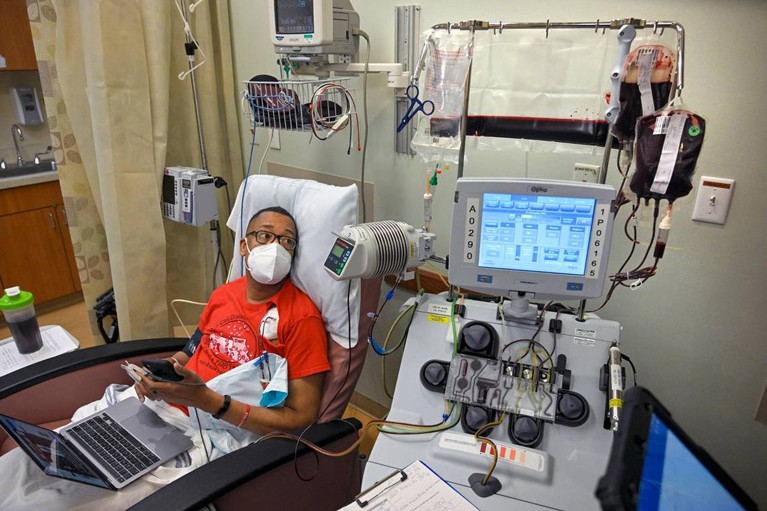
A person with sickle-cell disease receives a blood transfusion at a hospital in Kansas City, Missouri.Credit: Tammy Ljungblad/The Kansas City Star/Tribune News Service via Getty
Yet the way in which gene therapies are currently valued is riddled with difficulties.
Most value-based pricing models do not consider need, affordability or disease prevalence. Moreover, the perception of value varies for different populations and can change over time. In Europe and the United States, for example, sickle-cell disease is classed as a rare genetic disease (even though worldwide it is one of the most common inherited disorders). And this categorization changes how a drug to treat the disease is valued; societies are thought to be more willing to shoulder the costs of an expensive treatment if only a relatively small number of people are affected by the disease8.
Estimates of ‘value added’ assume that recipients of treatments are cured for life. But the data presented by drug companies to authorities, such as the United Kingdom’s National Health Service, often come from only two years of follow-up.
Those evaluating the drugs do not consider that lower-priced treatments might become available in the future — say, if some part of the manufacturing process becomes automated. Evaluators also assume that manufacturing will only ever happen in high-income countries, even though drugs could be produced more cheaply in nations such as India, where the costs of labour and locally produced components, including gene-editing reagents, are much lower than in Europe or the United States.
Perhaps most crucially, drug evaluators use clinical data, for instance on the number of times people report a pain crisis to health-care providers, collected only from those in the countries where they expect the drug to be marketed9. In other words, estimates of the value of gene therapies are based on clinical data that are not collected from most of the people with the disease that the therapies are designed to treat.
All this means that gene therapies are perceived to be less cost-effective and more expensive to produce than they would be if their development, production, marketing and uptake shifted to countries where the relevant diseases are most prevalent. For sickle-cell disease, this includes Nigeria, India, the Democratic Republic of the Congo, Tanzania and Uganda10.
Home grown
The capacity of LMICs to pursue research and development is much greater than many people in wealthier nations might assume. The Drugs for Neglected Diseases Initiative, an international non-profit organization, has brought 13 new drugs to market over the past 20 years, in part by including clinicians, researchers and trial participants from countries such as Ethiopia, Kenya, Malaysia, India and Brazil in the research-and-development cycle (see go.nature.com/3vj59yc).
Global inequities in COVID-19 vaccination have been a powerful reminder of the importance of local manufacturing of both vaccines and treatments. And governments across the world have been pushing hard for this.
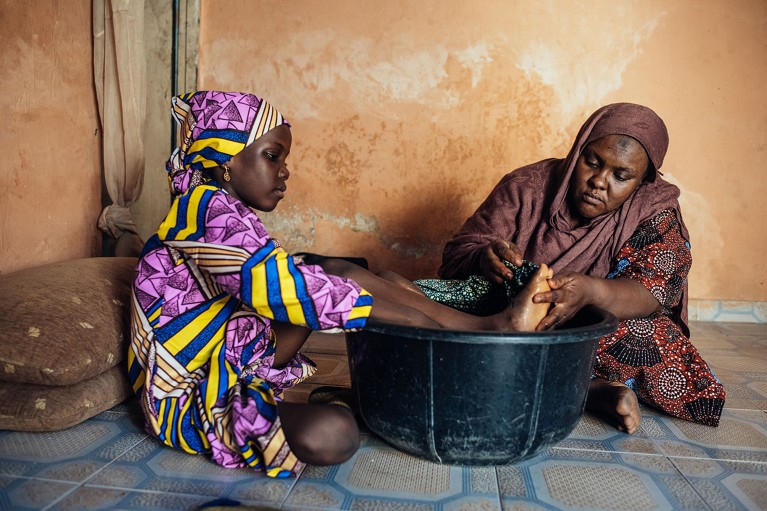
A woman in Kano, Nigeria, massages the legs of her daughter, who has sickle-cell disease.Credit: KC Nwakalor/New York Times/Redux/eyevine
Through initiatives such as the New Partnership for Africa’s Development, the African Union is increasingly supporting the local manufacturing of treatments, vaccines and interventions such as mosquito nets, for example. Similar investment is happening in India. In October last year, India’s equivalent of the US Food and Drug Administration, the Central Drugs Standard Control Organization, approved the use of a home-grown chimeric antigen receptor T-cell therapy, called NexCAR19, to treat blood cancers.
The same government buy-in, national entities and infrastructure must support the local manufacturing of approved gene therapies, to give local populations a chance to access them. The cost savings made by shifting the manufacturing of some of these therapies to Africa or Asia could improve people’s access to them in certain high-income countries too. This is particularly true in Europe, which has more regulatory flexibility than does the United States.
Once it became clear, in 2022 and 2023, that regulators would be reviewing both Casgevy and Lyfgenia and probably approving their use for sickle-cell disease, other biotech companies, including Aruvant Biosciences, based in New York City; Sangamo, based in Richmond, California; and Bioverativ, part of the multinational drug-maker Sanofi; abandoned the development of three gene-therapy products for the disease. Although these pipelines were lagging behind those for Casgevy and Lyfgenia, clinical trials had been indicating that these other drugs would also be effective and safe.
Two years of COVID-19 in Africa: lessons for the world
Agreements around intellectual property would need to be negotiated. But, in principle, abandoned drug-development pipelines could be transferred to LMICs immediately. This would jump-start research and development for gene therapies locally, without imposing high-income-country requirements on low-resource settings. In countries such as India, for example, the rules around what clinical treatments (if any) people should have received before undertaking gene therapy will differ from those derived from clinical data collected in the United States11.
Most of the intellectual property in cell and gene therapy is owned by academic research centres. But in cases where a commercial developer owns the intellectual property, tax incentives, expanded government funding or public–private partnerships could all support the transfer of technology to regions where the disease of interest is more prevalent.
To help to achieve this kind of technology transfer, governments of LMICs need to build the trust of US and European biotech corporations and academic research centres — not just by increasing their own investment in research and training, but also by conducting transparent assessments of their countries’ scientific, infrastructural and funding capacity.
There is considerable political will to address diseases that hit local populations the hardest. This year, Tanzania committed 3.6 billion shillings (around US$1,400,000) to support the use of bone-marrow transplants to treat children with sickle-cell disease. And depending on how much their costs can be brought down, there could be a strong global market for gene therapies.
No matter their income level, parents will do anything they can to save their child’s life. Since 2011, clinics in Nigeria have been providing bone-marrow transplants to Africans to treat sickle-cell disease. In India, hundreds of people have received a bone-marrow transplant to treat sickle-cell disease over the same period. In most cases, recipients and their relatives have crowdsourced the $25,000–50,000 needed per treatment.
Find a way
The Global Gene Therapy Initiative (GGTI), of which we are both founding members, aims to enable people anywhere in the world to find out more about the development of gene therapies. Last year, one of our colleagues, Elizabeth Merab, an award-winning Kenyan journalist in health and science, and a member of the GGTI’s international advisory board, died from complications of sickle-cell disease at the age of 31.
In 2022, Merab addressed various stakeholders, including one of us (J.E.A.), at a meeting about the role of gene therapies in treating sickle-cell disease and HIV at the Sunnylands Estate in Rancho Mirage, California. It had been three years since news outlets around the world had reported how, in a much-anticipated experiment, clinicians had used a CRISPR-based gene therapy to try to treat sickle-cell disease in a woman called Victoria Gray.
At the Sunnylands Estate, Merab, who was diagnosed aged ten, told us how she had overheard the doctor tell her parents that her options were limited. Hydroxyurea, a drug that reduces symptoms for some people, became available in the 1980s, but didn’t work for her. Later, she learnt about bone-marrow transplants, but her doctors told her that she would have to receive the treatment outside Africa and pay for it herself. Then, at the meeting, she learnt about gene therapy for sickle-cell disease.
“The only thing more difficult than hearing that you have a disease for which there are no cures, is to hear that you have a disease for which cures are available, but they are not available to you,” she told us.
Everyone with a devastating disease should have access to a cure when one exists. True progress will come only when low-income countries are included in the development of gene therapies.

